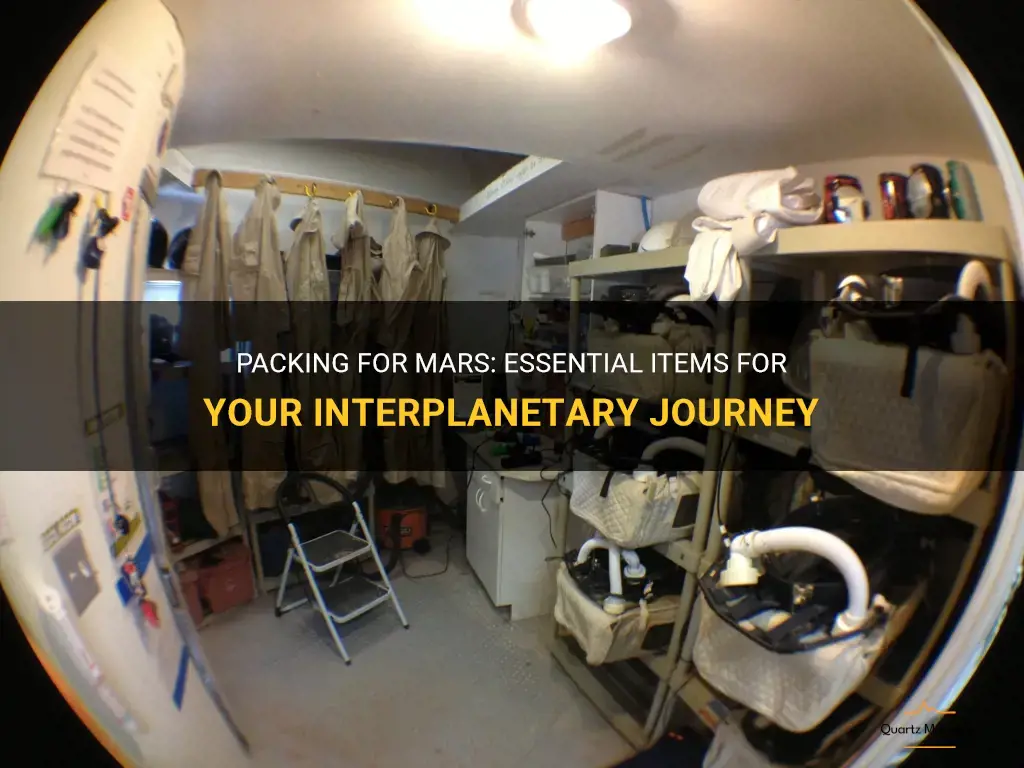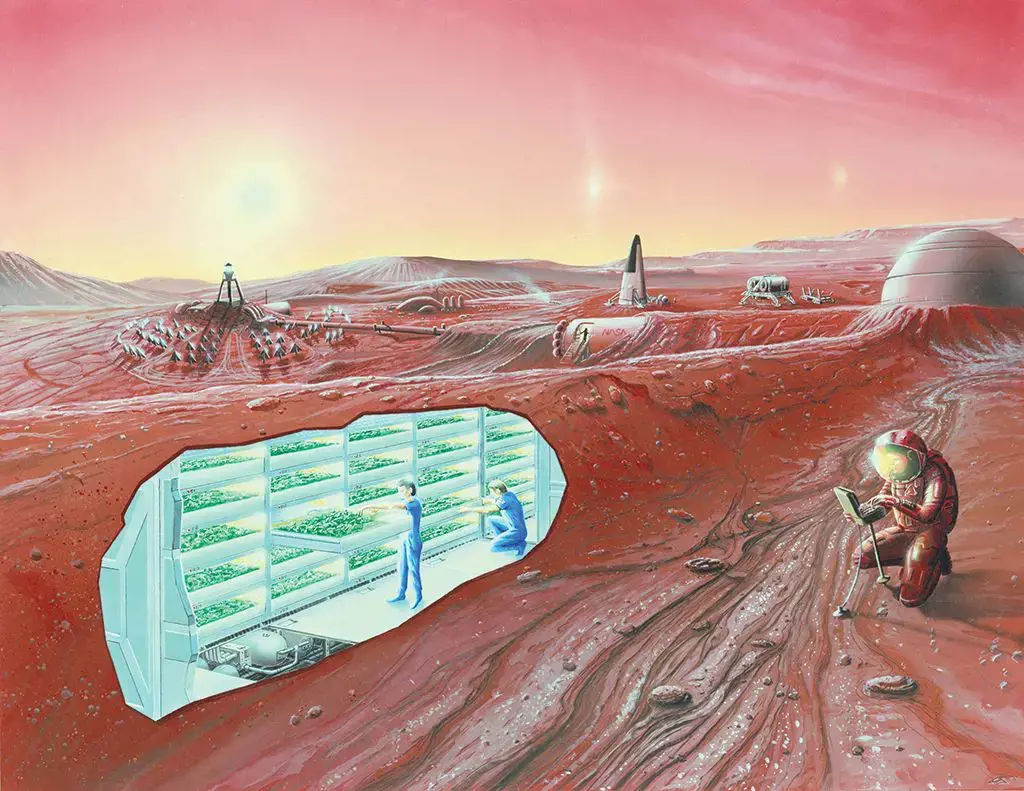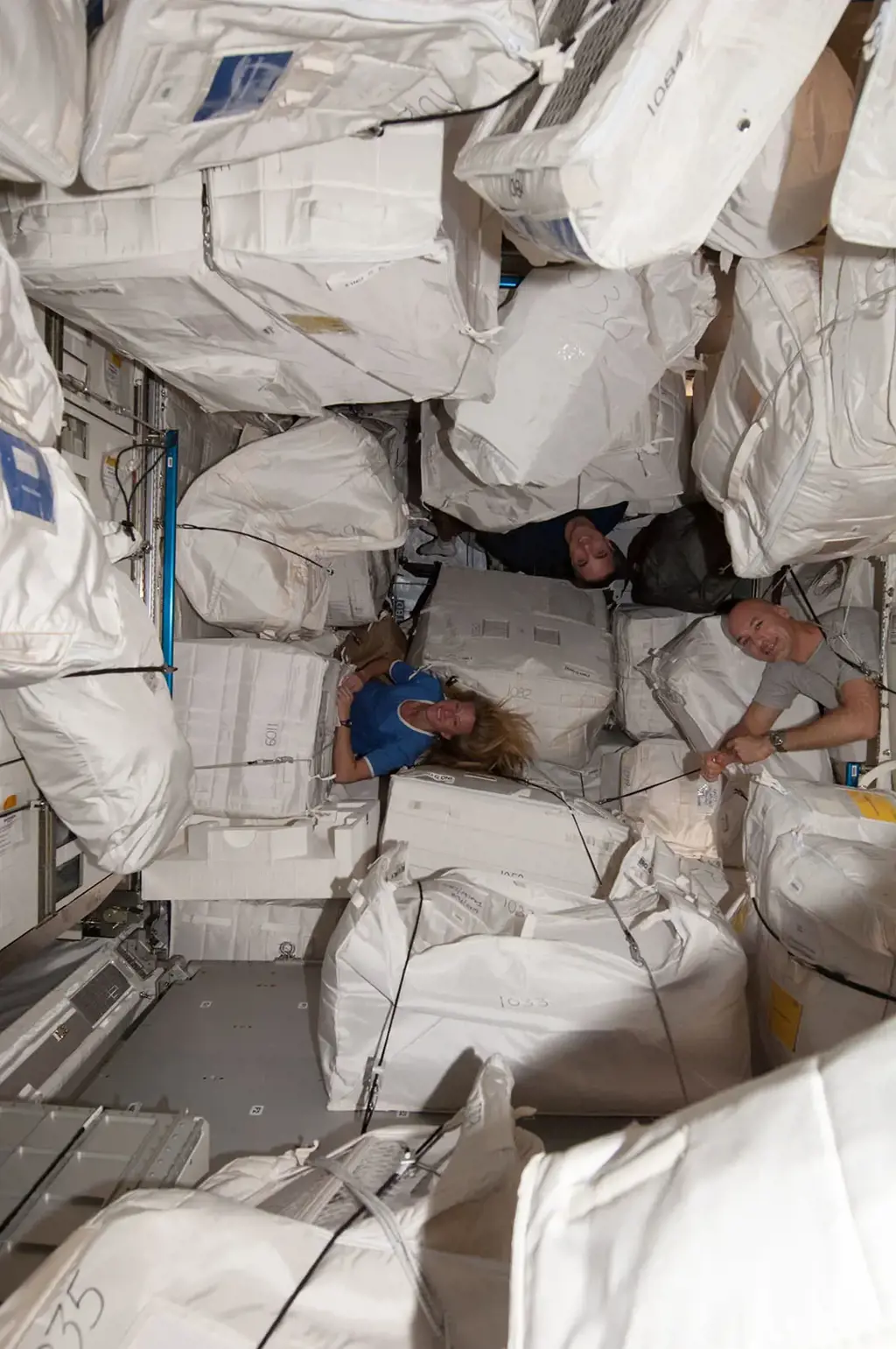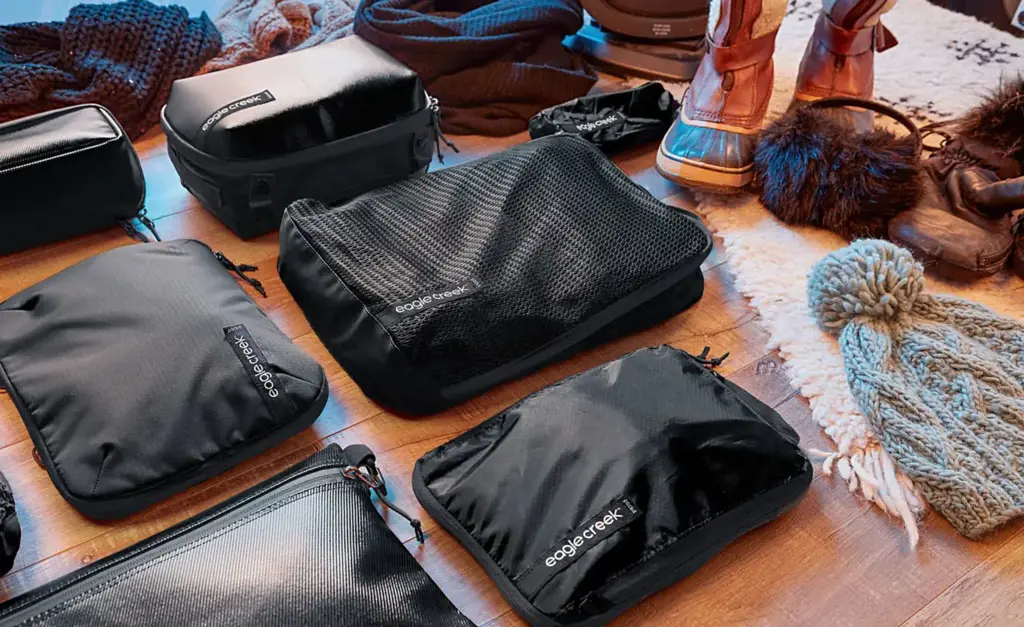
Are you ready to embark on the journey of a lifetime? Imagine leaving behind the confines of Earth and venturing into the unknown reaches of space. But before you can take that giant leap, you'll need to pack your bags. Packing for Mars: Essential Items for Your Interplanetary Journey is your comprehensive guide to ensuring you have everything you need for your interplanetary adventure. From spacesuits and oxygen tanks to freeze-dried meals and communication devices, this book will help you navigate the unique challenges of living and surviving in the harsh environment of outer space. So grab your checklist and get ready to pack your bags – Mars is waiting.
What You'll Learn
- What essential items should be included in a packing list for a trip to Mars?
- Are there any specific items needed for survival on Mars that differ from other space missions?
- How does the limited space and weight restrictions impact the packing process for a journey to Mars?
- What type of clothing and equipment is necessary to withstand the extreme conditions on Mars?
- Are there any special considerations for food, water, and other daily necessities when packing for an extended stay on Mars?

What essential items should be included in a packing list for a trip to Mars?

A trip to Mars is not something to be taken lightly. It is a major undertaking that requires careful planning and preparation, especially when it comes to packing. The journey to Mars can take several months, so it is important to pack all the necessary items to ensure the safety and well-being of the astronauts. In this article, we will discuss the essential items that should be included in a packing list for a trip to Mars.
- Space Suit: The most important item on the packing list for a trip to Mars is a space suit. This is the primary means of protection for the astronauts against the harsh conditions of space and the Martian environment. The space suit should be designed to provide adequate insulation, protection from radiation, and airtight seal to prevent the escape of oxygen.
- Life Support System: Another crucial item on the packing list is a life support system. This includes systems for providing breathable air, removing carbon dioxide, and filtering water. The life support system should be designed to sustain the astronauts for the entire duration of the trip and their stay on Mars.
- Food and Water: A trip to Mars will require a long-term supply of food and water. It is essential to pack a sufficient amount of both to sustain the astronauts for the duration of the journey and their stay on Mars. The food should be lightweight, non-perishable, and nutritionally balanced to meet the astronauts' dietary needs.
- Medications and First Aid: In case of any medical emergencies or illnesses, it is important to pack a supply of medications and a first aid kit. This should include basic medical supplies such as bandages, antiseptics, pain relievers, and antibiotics. The medications and first aid kit should be carefully selected to address a wide range of potential health issues.
- Communication Equipment: Communication with Earth will be essential during the trip to Mars. It is important to pack reliable communication equipment such as radios, antennas, and satellite dishes to enable regular communication with mission control and to send/receive important updates.
- Tools and Equipment: A trip to Mars will require various tools and equipment for scientific experiments, repairs, and maintenance. It is important to pack a wide range of tools such as wrenches, hammers, screwdrivers, and electrical equipment. Additionally, specialized equipment for conducting experiments and collecting data should also be included.
- Entertainment: A trip to Mars will be a long and arduous journey, so it is important to include some form of entertainment to keep the astronauts engaged and mentally stimulated. This could include books, movies, music, or virtual reality games.
In conclusion, a trip to Mars requires careful planning and preparation, especially when it comes to packing. The essential items that should be included in a packing list for a trip to Mars include a space suit, life support system, food and water, medications and first aid, communication equipment, tools and equipment, and entertainment. These items are crucial for the safety and well-being of the astronauts and for the success of the mission.
Essential Items to Pack for an August Trip to South Africa
You may want to see also

Are there any specific items needed for survival on Mars that differ from other space missions?

Survival on Mars presents unique challenges that require specific items not needed for other space missions. The hostile environment on Mars necessitates careful planning and preparation in order to ensure the survival of astronauts. In this article, we will explore the specific items needed for survival on Mars and how they differ from those used in other space missions.
One of the most crucial items needed for survival on Mars is a reliable spacesuit. Unlike spacesuits used on the International Space Station (ISS) or during spacewalks, Mars suits need to be much more robust and capable of protecting astronauts from the harsh Martian atmosphere. The suits must be able to regulate temperature, provide oxygen, and protect against the planet's extreme cold and thin atmosphere. Additionally, Mars suits must be designed to be durable and resist damage from the abrasive dust and rocks found on the planet's surface.
Another important item needed for survival on Mars is a habitat that can shield astronauts from radiation and provide a livable environment. Unlike other space missions where astronauts can rely on the protection of the Earth's magnetic field and atmosphere, Mars lacks these natural safeguards. Therefore, habitats on Mars need to be designed with materials that can shield against harmful radiation. They must also be self-contained and capable of providing astronauts with a breathable atmosphere, water, and a source of food.
In addition to spacesuits and habitats, survival on Mars also requires special equipment for transportation and exploration. The rugged Martian terrain necessitates the use of rovers or other vehicles that can traverse the uneven and rocky landscape. These vehicles must be able to withstand the dusty conditions and extreme temperatures found on Mars. They also need to be equipped with advanced navigation systems to ensure astronauts can safely explore the planet's surface.
Furthermore, communication systems are crucial for survival on Mars. Unlike the relatively close proximity of the ISS to Earth, communication delays between Mars and Earth can be up to 20 minutes one way. This makes real-time communication impossible and highlights the need for robust communication systems on Mars. These systems must be capable of handling the significant time delays and provide reliable means of communication between astronauts on Mars and mission control on Earth.
In conclusion, survival on Mars requires specific items that differ from other space missions. The harsh Martian environment necessitates a robust spacesuit capable of protecting astronauts from the extreme conditions. Additionally, habitats need to be designed to shield against radiation while providing a livable environment. Special equipment for transportation and exploration, as well as reliable communication systems, are also essential for survival on Mars. By carefully considering these unique needs and providing the necessary equipment, we can ensure the success of future missions to the Red Planet.
The Essential Checklist for a Memorable Surf Holiday
You may want to see also

How does the limited space and weight restrictions impact the packing process for a journey to Mars?

As humans continue to explore the possibility of journeying to Mars, one of the many challenges they face is the limitation in space and weight restrictions for packing the necessary supplies. The long and arduous journey to Mars requires careful planning and consideration of every item that is packed. Each piece of equipment must serve a specific purpose and essential items must be prioritized over non-essential ones.
Space is a precious commodity when it comes to interplanetary travel. The size of a spacecraft is limited, and every inch is allocated to serve a specific purpose. Astronauts must carefully choose what items to bring, ensuring that they can efficiently utilize the available space. Items that are large or bulky are often deemed impractical, and efforts are made to find smaller, more compact alternatives.
Weight is also a crucial factor in the packing process. The spacecraft must adhere to weight restrictions to ensure safe and successful launches and landings. The energy required to escape Earth's gravity and travel to Mars is immense, and any unnecessary weight hampers the efficiency of the spacecraft. Therefore, astronauts must meticulously evaluate the weight of every item they wish to bring, making sure that it aligns with the mission objectives and is worth the valuable resources it consumes.
The packing process for a journey to Mars involves several steps to optimize space and weight efficiency. First and foremost, the mission objectives are established, outlining the goals and requirements of the journey. Based on this, a comprehensive list of necessary equipment and supplies is generated. Essential items such as life support systems, food, water, and medical supplies take precedence over non-essential items.
To maximize space utilization, astronauts utilize innovative storage solutions. They carefully plan the arrangement of items, taking advantage of every nook and cranny. Items are often packed in modular containers that can be stacked or compressed, allowing for efficient storage.
Weight restrictions require astronauts to evaluate the necessity of every item they wish to bring. Items that serve multiple purposes or can be replaced by smaller alternatives are favored. For example, a single tool that can perform multiple functions would be preferred over a collection of specialized tools. Additionally, astronauts may opt for lightweight materials for certain items, sacrificing durability to reduce weight.
Another approach to maximize space and weight efficiency is the concept of reusability. Items that can be reused throughout the journey are valued over single-use items. This not only reduces the number of items required but also minimizes waste and conserves resources.
In conclusion, the limited space and weight restrictions for a journey to Mars have a significant impact on the packing process. Astronauts must carefully evaluate each item, ensuring it serves a specific purpose and justifies the use of valuable space and resources. Through careful planning, innovative storage solutions, and prioritization of essential items, astronauts are able to optimize space and weight efficiency, enabling successful missions to Mars.
The Essential Packing List for Exploring Acadia National Park
You may want to see also

What type of clothing and equipment is necessary to withstand the extreme conditions on Mars?

Exploring Mars is a fascinating endeavor that humans have been dreaming about for centuries. However, the harsh environment on the Red Planet poses numerous challenges that need to be overcome in order to ensure the safety and well-being of astronauts. One of the most critical aspects of preparing for a Mars mission is determining the type of clothing and equipment that will be necessary to withstand the extreme conditions on Mars.
The average temperature on Mars is about -80 degrees Fahrenheit (-60 degrees Celsius), significantly colder than any place on Earth. In addition, the atmosphere is extremely thin, with only about 1% of the pressure found at sea level on Earth. These factors make it essential to have protective clothing and equipment that can provide insulation and maintain a habitable environment for astronauts.
To withstand the extreme cold on Mars, astronauts will need specialized clothing that is designed to retain body heat. This could include insulating layers made of high-tech materials such as aerogel or advanced synthetic fibers. These materials have excellent thermal properties and can effectively trap heat, keeping the astronauts warm in the frigid Martian environment. In addition, the clothing should be lightweight and flexible to allow for ease of movement during exploration and work activities.
Another critical aspect is protecting astronauts from the thin atmosphere and high levels of radiation on Mars. The Martian atmosphere offers minimal protection against harmful radiation from the Sun and cosmic rays. Therefore, the clothing and equipment must be equipped with shielding materials, such as multi-layered fabrics or specially designed shields, to minimize radiation exposure. These shielding materials could be made of lead, which is highly effective at blocking radiation, or other lightweight alternatives that offer comparable protection.
Furthermore, the equipment used on Mars must be carefully chosen and designed to withstand the extreme conditions. For example, vehicles and rovers must have reliable heating systems to prevent critical components from freezing in sub-zero temperatures. The materials used in the construction of these vehicles should be resistant to the corrosive effects of the Martian dust, which is abundant on the planet's surface. Additionally, all electronic equipment should be well-insulated to prevent damage from the extreme temperature variations.
In order to ensure the efficiency of the clothing and equipment, extensive testing and simulations are conducted on Earth to replicate the conditions on Mars. Various laboratory experiments and field tests are performed to evaluate the performance and durability of the materials and designs. These tests help to identify any shortcomings or areas for improvement, allowing for refinements before actual deployment to Mars.
In conclusion, exploring Mars requires careful consideration of the extreme conditions astronauts will face. Adequate clothing and equipment are crucial to protect against the cold temperatures, thin atmosphere, and high levels of radiation. Insulated clothing made of advanced materials, along with shielding equipment to minimize radiation exposure, are key components for survival on the Red Planet. Additionally, vehicles and equipment must be designed to withstand the harsh environment and undergo rigorous testing before being sent to Mars. With the right clothing and equipment, humans can safely venture further into the solar system and unravel the mysteries of our neighboring planet.
Essential Packing Tips for December in Israel
You may want to see also

Are there any special considerations for food, water, and other daily necessities when packing for an extended stay on Mars?

When packing for an extended stay on Mars, there are several special considerations to keep in mind when it comes to food, water, and other daily necessities. The harsh conditions and limited resources on the red planet make it essential to plan and pack carefully. This article will outline the key considerations for packing these essential items for a successful mission to Mars.
Food:
- Shelf life: When it comes to food, the long journey and stay on Mars require items with a long shelf life. Canned or dehydrated food is ideal as it can last for several years without spoiling. Freeze-dried meals are also a popular option, as they are lightweight and easy to rehydrate with water.
- Nutritional content: It is crucial to pack food that provides a balanced and nutritious diet. Astronauts on Mars need a sufficient intake of vitamins, minerals, proteins, and carbohydrates to maintain their health and energy levels.
- Variety: Having a diverse range of food options is essential for mental well-being during long-duration missions. Include a mix of fruits, vegetables, grains, proteins, and treats. Psychological support is crucial for the crew to stay motivated and maintain their mental health during their stay on Mars.
Water:
- Conservation: Since water is a limited resource on Mars, it is crucial to conserve and reuse it whenever possible. Water should be carefully managed and recycled to maintain a sustainable supply throughout the mission.
- Filtration and purification: Advanced water filtration systems should be included in the packing list to ensure the crew has access to clean and safe drinking water. These systems should be able to remove any contaminants or impurities present in the local groundwater or recycled water.
- Storage: Proper storage containers and systems should be packed to prevent water loss due to evaporation or leakage. Secure and airtight containers are necessary to store water effectively during the mission.
Other Daily Necessities:
- Clothing: The Martian environment is extremely cold and has high levels of radiation. Packing thermal clothing and radiation shielding materials is vital to protect the crew from these harsh conditions.
- Medicine and First Aid: A well-stocked medical kit should be packed, including essential medications, bandages, and equipment for minor surgical procedures. Due to the distance from Earth, it may take months for medical supplies to arrive in case of an emergency.
- Communication equipment: Reliable communication systems and devices are crucial to maintain contact with mission control and the crew's mental well-being. A variety of communication devices should be packed, including radios, satellites phones, and backup systems.
It is important to note that packing for a mission to Mars involves collaboration between scientists, engineers, and experienced space travelers. These professionals work together to develop comprehensive packing lists that consider the unique challenges and constraints of a mission to Mars. Each mission may have its specific requirements and constraints that must be considered when packing for an extended stay on the red planet.
In conclusion, packing for an extended stay on Mars requires careful consideration of food, water, and other daily necessities. Planning for a sustainable food supply, adequate water management, and essential daily items is crucial to ensure the success and well-being of the crew. By taking into account the special considerations outlined in this article, future missions to Mars can be better prepared for the challenges they will face on the red planet.
Must-Have Items for a Long-Term Internship: A Comprehensive Packing Guide
You may want to see also
Frequently asked questions
When packing clothing for Mars, it is important to prioritize functionality and durability. The extreme conditions on Mars, such as the thin atmosphere and large temperature variations, necessitate special considerations. It is recommended to pack thermal underwear, insulating layers, and airtight spacesuits to protect against the extreme cold and low pressure. Additionally, packing sturdy, non-slip boots and gloves for exploration purposes is crucial. Overall, the clothing selection should focus on providing thermal regulation, protection from radiation, and the ability to withstand the harsh environment on Mars.
When it comes to personal items on a Mars mission, space is at a premium, so it is important to prioritize necessities and items that will contribute to the mental well-being of the crew. Essentials such as toiletries, medications, and personal hygiene products should be included. Additionally, bringing personal mementos, such as pictures or small sentimental items, can help maintain a sense of connection to loved ones back on Earth. It is crucial to remember that personal items should be limited in size and weight to ensure efficient use of space and resources during the mission.
When packing food and supplies for a journey to Mars, it is important to consider the long duration and limited resources available. Non-perishable, nutrient-dense food items are essential to ensure the crew's nutritional needs are met. Items such as dehydrated and freeze-dried meals, protein bars, and vitamin supplements are commonly included in the food supplies. In addition to food, it is important to pack a sufficient amount of water and water filtration systems to ensure hydration. Other important supplies to pack include medical kits, tools, communication devices, and spare parts for equipment. It is crucial to calculate and pack these supplies in a way that maximizes efficiency and minimizes waste.







